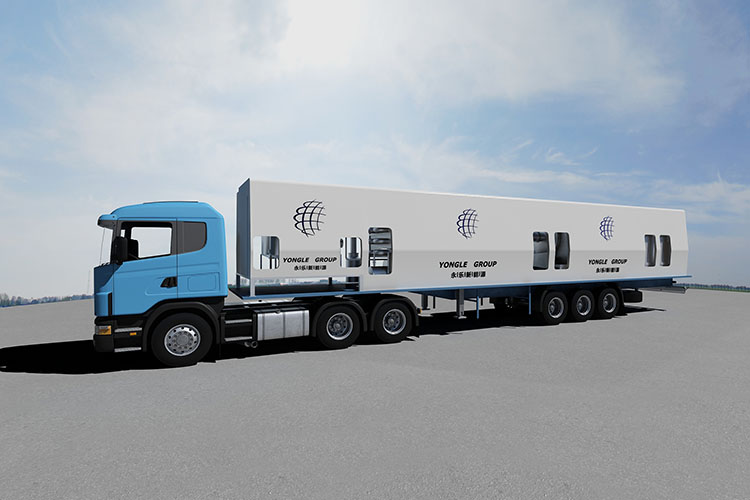The effective disposal of medical waste is an indispensable part of public health management. With the expansion of medical institutions and service systems, the amount of medical waste generated has been increasing year by year. Traditional centralized treatment facilities often find it difficult to fully cope with peak demand, leading to problems such as waste accumulation and secondary pollution. Therefore, a new form of emergency response - medical waste disposal cabin - is gradually being applied to the daily disposal of medical waste. Fangcang has become an important supplementary means for medical waste treatment due to its flexibility and efficiency. This article will explore in detail the advantages of medical waste disposal shelters and their important role in the medical waste management system.
Firstly, the mobility and flexibility of medical waste disposal shelters are highly advantageous. A shelter is a modular and movable structure that can be quickly deployed to various regions according to actual needs, including remote areas and areas with high processing demands. For remote areas, the disposal of medical waste is often constrained by logistics and time costs. The deployment of shelters enables medical waste to be processed locally, avoiding the risk of secondary pollution caused by long-distance transportation. This feature significantly reduces the demand for cross regional transportation of medical waste, allowing waste to be treated at the source, greatly shortening the exposure time of waste and reducing environmental pollution risks.
Secondly, medical waste disposal shelters can alleviate the pressure on centralized treatment facilities. In hospitals or large medical institutions, the amount of medical waste generated is relatively high, and centralized treatment facilities may find it difficult to process large amounts of waste in a short period of time. As an effective tool for dispersing pressure, medical waste disposal shelters can be quickly put into use, reducing the burden on centralized treatment facilities and effectively avoiding environmental and health risks caused by waste accumulation. The flexibility of the distribution of the shelter enables it to be processed in multiple locations, thereby achieving synchronous operations in multiple locations and effectively alleviating the pressure on the processing facilities. This processing mode can respond more flexibly in situations where medical demand fluctuates greatly, adapting to different scales and types of medical waste processing needs.
Reducing the risk of secondary pollution is another major advantage of medical waste disposal shelters. The interior of the shelter is usually equipped with advanced processing equipment, such as high-temperature disinfection equipment, microwave treatment equipment, etc., which can perform on-site harmless treatment of medical waste. Compared to transporting to centralized treatment centers far from the source, makeshift shelters can better control the sources of pollution during the medical waste treatment process, reducing the possibility of leaks or other accidental pollution events during transportation. Especially for highly infectious waste, shelters can safely handle it at the place of production, prevent the spread of infectious sources, and greatly reduce the potential threat of waste disposal to the surrounding environment.
In addition, the rapid response and operational capabilities of the shelter also make it perform well in daily handling and emergency response. Compared to traditional fixed processing facilities, the construction period of the shelter is shorter, and it can be installed and debugged within a few days and immediately put into use. The modular design of the shelter makes it easy to transport and install, and can adjust the processing scale according to actual needs to adapt to medical waste treatment tasks of different intensities. The processing equipment inside the cabin can be adjusted according to demand to ensure flexible processing capacity and timely and safe disposal of waste.
From an economic perspective, the application of makeshift shelters has reduced construction and operational costs. The construction of fixed medical waste treatment facilities usually requires high capital investment and a long construction period, while makeshift shelters have significantly lower costs due to their modular design and reusability. In the daily management of medical institutions, shelters can be used as temporary treatment facilities to provide supplementary support when there is a large amount of waste generated. At the same time, after completing the processing tasks, the shelter can also be transferred to other areas or used as a backup for future use. In this way, the flexibility of the cabin not only saves costs, but also meets the economic and sustainable development needs of medical waste management.

Finally, the design features of the shelter significantly enhance the safety of the operators. The disposal of medical waste carries high health risks, especially when there may be infectious and polluting waste present. The enclosed structure of the shelter and the internal disinfection system ensure the controllability of the internal environment, providing a safe working environment for waste disposal personnel. During the treatment process, the interior of the shelter can be thoroughly disinfected and sealed, and the equipped exhaust gas treatment system ensures that harmful gases generated during the treatment process will not leak out, further ensuring environmental safety.
In summary, medical waste disposal shelters have become an effective supplementary means in the medical waste treatment system due to their high mobility, flexibility, and economy. It not only disperses the pressure of centralized treatment facilities, but also provides a safe on-site treatment method, effectively reducing the risk of secondary pollution. The application of makeshift shelters not only contributes to the harmless treatment of medical waste, but also promotes the continuous improvement of the medical waste management system.
Yongle Environmental Protection is mainly engaged in the research and development, production and sales of complete sets of technical equipment for organic solid waste disposal and comprehensive utilization. Production and manufacturing, domestic waste treatment equipment, tire pyrolysis equipment, medical waste disposal equipment, hazardous waste disposal equipment, and achieve efficient and comprehensive utilization of resources through independently developed low-temperature anaerobic pyrolysis equipment technology solutions.
Tags:Advantages of medical waste disposal cabin,medical waste disposal cabin,YONGLE GROUP
 Latest news
Latest news


























